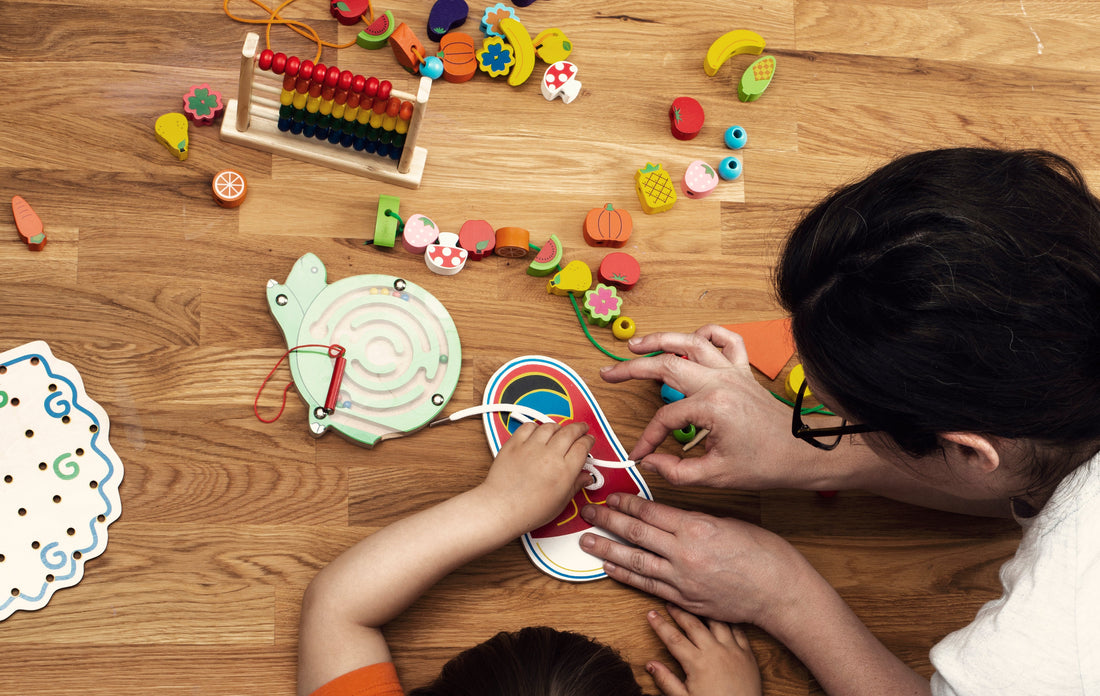
What Is "The Montessori Method?" A guide for parents.
A Parent's Guide to the Best Age to Start Teaching Kids
Every parent dreams of giving their child the best start in life. But when it comes to learning, many parents find themselves asking the same question: When is the best age to start teaching kids? The truth is, there's no one-size-fits-all answer, but understanding the key milestones in a child’s development can help you unlock their potential and set them up for success.
This guide breaks down various age ranges and offers practical tips to equip parents with the tools and confidence to nurture their child’s love of learning from the very beginning.
The Early Years Matter Most
Research shows that the brain develops rapidly during the first five years of life. Neuroscience has revealed that 90% of a child’s brain growth happens by the age of 5! These formative years are the foundation for lifelong learning, making it a crucial time to encourage curiosity and exploration.
Birth to Age 2
At this stage, children are learning through their senses. Babies absorb everything around them like little sponges, so even simple interactions can be incredibly meaningful.
- What you can do: Talk to your baby! Narrate your day, point out objects, and use facial expressions to build their communication skills. Reading picture books and singing songs is also a great way to make connections.
Ages 3 to 5
The preschool years are incredible for laying the groundwork for basic skills like language, counting, and social interactions. Children at this age thrive in playful, hands-on learning environments.
- What you can do: Introduce fun learning activities like ABC games, puzzles, and counting objects around the house. Role-playing and storytelling activities spark creativity and teach problem-solving. Most importantly, nurture their sense of independence by encouraging them to try new things.
Building Lifelong Learning Habits in School-Age Children
When kids enter school around age 6, structured education begins, but that doesn’t mean the learning stops at the classroom door. Cultivating positive habits during this time sets the tone for academic achievement and life skills.
- Ages 6 to 8: At this age, kids develop critical thinking skills and start to show preferences in what they enjoy learning. This is the ideal time to teach them the concept of perseverance and reward effort over outcomes. Offer plenty of praise for their achievements, and when they stumble, guide them gently rather than dwelling on failure.
- Ages 9 to 12: These are the prime years to encourage goal-setting and taking responsibility. Help your child explore their interests. Whether it’s science, art, or sports, support their passions! Introducing life skills at this stage, like saving money, time management, or cooking, will also allow them to discover independence in practical ways.
Every Child Learns at a Different Pace
It’s tempting to compare your child’s progress with others, but remember, each child develops at their own pace. Milestones provide guidance but are not rules. The goal isn’t to rush them but rather to meet them where they are and help them grow step by step.
Consistency Is Key
Whether you’re teaching your toddler how to form words or helping your tween master fractions, consistency and patience are essential. Children thrive when education is a part of the daily routine, even if it looks different for every family.
How to Stay Consistent
- Designate a specific time during the day for reading or learning activities.
- Use everyday moments as teaching opportunities (e.g., cooking together can teach maths).
- Encourage questions and praise curiosity.
- Celebrate progress, no matter how small!
Your Role as a Parent
As parents, you are your child's first and greatest teacher. By being present, providing encouragement, and filling their world with enriching experiences, you’re already setting them up for success.
It’s not about being perfect. It’s about making small, thoughtful choices that support their development and inspire their love of learning.
It’s Never Too Early to Start
The best age to begin teaching kids is wherever they are right now. Whether they’re babbling, asking endless "why" questions, or preparing for their first school project, every moment is a learning moment.
Start from where they are, guide them forward, and remember that every small step builds the path to future success. Being patient, consistent, and encouraging will make all the difference on their learning journey.
Looking for even more personalised tips to support your child’s growth? Subscribe to our newsletter today for expert advice, activity ideas, and a whole lot of inspiration for parents ready to empower their children!
What Is The Montessori Method
Curious about how the Montessori method can transform your child’s learning? Whether you're a parent looking to encourage independence or simply want a more hands-on approach to education, this guide will give you the essentials to get started. From its inspiring history to practical toys and games, you’ll discover how this revolutionary approach shapes confident, curious children.
A Quick Introduction to the Montessori Method
The Montessori method is more than just a teaching style; it’s an entire philosophy of education. Created by Maria Montessori, an Italian physician and educator, the method was first introduced over 100 years ago. Montessori believed that children learn best when they are active participants in their own education, rather than passive recipients of information.
Central to this approach is the idea of fostering independence. Instead of directing children every step of the way, the Montessori method encourages them to explore, problem-solve, and take initiative. It’s about giving children the tools they need to learn at their own pace, driven by their natural curiosity.
Not limited to schools, this method is also a fantastic philosophy for parents to adopt at home. But what does it look like in practice?
Key Principles of the Montessori Method
1. Child-Led Learning
Montessori classrooms and philosophies are designed around children following their own interests. This principle can be used at home by observing your child’s passions and encouraging activities that tap into their curiosity, whether that’s building with blocks, painting, or experimenting with sensory bins.
The golden rule? Guide, don’t micromanage.
2. Prepared Environment
One of the standout features of Montessori is its ‘prepared environment’. The idea is that children learn best when they are in a structured, accessible, and clutter-free space that encourages independent exploration.
At home, this might mean having shelves at child-height stocked with neatly organised toys, books, and materials they can access without assistance. All items should have a clear purpose and be chosen to inspire learning.
3. Hands-On Learning
Montessori education is about doing. Hands-on activities not only hold children’s attention but also help them internalise new skills. This is why you won’t find traditional lectures, desks, or chairs in Montessori spaces. Instead, you’ll see tactile experiences—toddler-sized kitchens for pretend play, math manipulatives to visualise counting, and puzzles to encourage critical thinking.
4. Respect for the Child
A hallmark of the Montessori approach is respect for each child’s individuality. This means respecting their pace of learning and providing activities suited to their needs and developmental stage.
A Montessori home might encourage practical life skills from an early age, trusting that even toddlers can learn to pour their own water or help with simple chores when provided with the right tools and guidance.
Practical Ways to Apply Montessori at Home
You don’t need to enroll your child in a Montessori school to harness its magic. With a few thoughtful additions and adjustments, your home can become an environment that supports independent learning.
Toys to Encourage Montessori Learning
The best Montessori toys are simple, purposeful, and made from natural materials like wood or fabric. Some must-haves include:
- Stacking toys and blocks for improving motor skills and spatial awareness.
- Shape sorters and puzzles to develop problem-solving skills.
- Sensory bins filled with grains, beans, or sand to encourage exploration.
- Bead threading sets for hand-eye coordination and creativity.
Games That Teach Big Lessons
Montessori games are often open-ended. Instead of strict rules, they allow children to explore, experiment, and use their imaginations. Here are a few ideas to get started:
- Treasure hunts using cards with pictures of objects around the house to practice vocabulary.
- Matching games with flashcards featuring colours, animals, or shapes.
- Number boards or counting sets where children can pair numbers with beads or counters.
Remember, the goal isn’t necessarily the activity itself, but what it encourages your child to learn naturally while doing it.
Empowering Everyday Activities
One of the easiest and most rewarding ways to implement the Montessori method at home is by involving your child in practical life activities. These are simple everyday tasks that teach independence while boosting confidence.
- Allow your child to help prepare meals. Get them involved in age-appropriate tasks, like rinsing vegetables or spreading butter.
- Set up a child-sized cleaning station. A small brush and dustpan or spray bottle filled with water lets them take part in tidying up their own messes.
- Create a self-care area. A low mirror, brush, and tissues enable them to practise washing their hands, combing their hair, or wiping their face independently.
By stitching Montessori principles into daily routines, you not only cultivate a love of learning but also boost your child’s self-esteem.
Benefits of the Montessori Method for Parents and Children
Adopting the Montessori approach can have incredible results.
- For children, it nurtures independence, curiosity, and a lifelong love of learning. Montessori kids are often more confident and capable of making decisions because they’re used to exploring and solving problems themselves.
- For parents, it’s a chance to better understand how your child learns and how to work with—rather than against—their natural instincts. Plus, seeing your child thrive independently is incredibly rewarding.
It’s about shifting from controlling to guiding. Instead of saying, “Don’t make that mess,” you find joy in moments like, “Wow, they’re peeling a banana all by themselves!”
Montessori and the Parent Community
The Montessori method beautifully ties into ideas of community and shared learning. Modern Montessori parents often connect through online forums, meetups or playgroups to share ideas and support one another.
Don’t know where to start? Facebook groups and local parenting communities often have Montessori groups with excellent resources, from activity ideas to stories about adapting the approach to different cultures or homes.
By immersing yourself in this community, you’ll find ample inspiration to keep Montessori alive in both big and small ways.
Discover the Montessori Difference Today
The Montessori method is more than a style of education; it’s a way of empowering children to take charge of their learning and build confidence in their abilities. What’s more, integrating its principles into your home doesn’t require an extensive budget or rigid rules. It’s about being intentional, observant, and encouraging.
